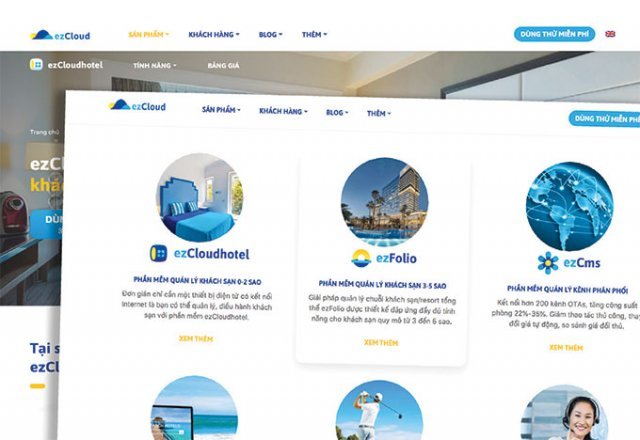 |
EzCloud, a Vietnamese hotel tech startup, officially launched a new brand identity earlier this year after three months of preparations.
With six years in business, it is one of only a few startups in Vietnam to pay attention to building its brand in the hotel management software industry.
With the ambition of providing Vietnamese technology for Vietnamese people and exploiting global tourism markets, six young graduates from the University of Engineering and Technology (Vietnam National University) created ezCloud in 2013. It focuses on niche markets instead of large hotels dominated by major rivals in the hotel management software industry. The startup focused on approaching small and medium-sized hotels that haven’t maximized their operations and management systems.
Though fully assessing the potential of the market and possessing its own technology, ezCloud still faced a host of difficulties. “In the beginning, we had no funds for recruiting employees, and each co-founder managed one field, so we had four people researching products and two working on sales,” said Mr. Dang Thanh Trung, Co-founder and Chief of Innovation Officer at ezCloud.
In 2016, it launched ezCloudhotel, a hotel management app for two-star hotels that received a warm response. But the co-founders realized this wouldn’t be enough for their “go global” goal. Product quality alone can’t guarantee success - the startup needed a marketing strategy. In the initial days of its marketing investment, it had difficulties because it didn’t know how to promote the brand and made many mistakes, according to Ms. Tran Thi Thuy Duong, Chief Marketing Director at ezCloud. The co-founders are also all engineers, with no knowledge or skills in marketing.
Focusing more on building the brand, the startup seized market share in the industry with 3,000 customers and serves 1,100 new customers from zero to five-star hotels each year.
Ms. Dang Thanh Van, Chairwoman of the Board of Directors at Thanhs Brand JSC, said that while advertising only pulls in customers the first time, marketing helps in making the customer return for a second and third time and the brand can go further, creating loyalty among customers and pulling in their acquaintances. While a business could sell a product for VND10 million ($430) by investing only in advertising, if it also invested in branding it could sell the product at a price at least 30 per cent higher.
FROM THE BEGINNING …
A common story for startups is that the team is initially quite happy. But when they earn revenue their operations become sporadic as they lack a common vision for subsequent phases. This is a time for business owners to think about establishing a brand philosophy, through a mission and vision for the company, according to Ms. Van.
“A good vision is clear and transformed into a deployment plan,” she explained. “A beautiful mission must first inspire the entire team. The brand needs to be unique. But not unique in the market; unique in the minds of customers. Branding, however, is not just about designing a logo or building a media campaign. The whole production and sales process is within the overall branding strategy. The results must be measured specifically, by growth and revenue as well as the size of the company.”
When the startup has customers and a steady stream of revenue is the time to fully build a brand strategy and marketing strategy. But many startups mistakenly build brands just to make the business famous. The brand is the soul of an enterprise, and what the company is pursuing and what values it holds should be seen through the product, according to Mr. Mai Xuan Dat, CEO and Founder of SEONgon, a local digital agency.
Branding should start from the inside and not be viewed as meaning throwing money away to make the company famous. “Without a specific form of business, specific culture, specific brand, and specific personality, the company may approach more customers but few understand what the company is,” he emphasized. In order to be consistent in business development, startups should bolster knowledge about the brand name from the beginning, and first of all knowledge about marketing.
… TO KEY POINTS
 |
The core task of a brand strategy is to create a solid and emotional position, taking a place in the minds of customers. “The peak of branding is making customers love the brand,” Ms. Van said. “When they love the brand, they always look for the brand. This determines the loyalty of customers, even when the brand is in crisis.” Of course, to get to this level, the brand will be challenged in a series of touch points with customers.
The customer experience is gradually changing in the era of Industry 4.0, so customer touch points for the company also change. Quoting Mr. Jeff Bezos from Amazon, Mr. Doan Duc Thuan, Managing Director of StrategyM Consulting, said there are usually four key touch points for customers. First is the zero moment of truth, when there is a need for a product but customers either think about the company or don’t. The essence of the brand is to answer the question: who is the company in the minds of targeted customers?
Second is the first moment of truth, when there are two products on the shelf or on the selection screen - one from the company and one from its rival. Which one will the customer choose? Third is the second moment of truth: as customers experience the product, it feels like what the company promised. Fourth is the ultimate moment of truth, when the brand is what people say about you when you’re not there. When customers in the target segment talk to each other about the company, the trust effect increases many times compared to the brand talking about itself.
“The customer journey will go through these four touch points,” Mr. Thuan said. “Therefore, the money outlaid and the media activities conducted need to pay attention to them.” In particular, the first touch point costs money that isn’t immediately recovered. The second touch point invests in the supply chain and distribution channel. The third touch point focuses on the product and service experience, and the fourth is investing in loyalty programs. “Nothing happens if money is only spent on one touch point,” he underlined. VN Economic Times
Anh Tuyet & Nghi Do
 Vietnamese startups need to pay attention to their branding strategy if the aim is to 'go global'." itemprop="description" />
Vietnamese startups need to pay attention to their branding strategy if the aim is to 'go global'." itemprop="description" />